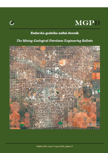Theory of deterministical and stochastical indicator mapping methods and their applications in reservoir characterization, case study of the Upper Miocene reservoir in the Sava Depression
DOI:
https://doi.org/10.17794/rgn.2017.3.5Abstract
The paper describes indicator based geostatistical methods (Indicator Kriging and Sequential Indicator Simulations),mostly used for facies mapping or facies modeling. Although it is assumed that in facies modelling variables should be descrete, it is possible to apply these methods on continuous variables as well. Continuous variables such as porosity can very well describe lithofacies. Methodology includes series of cut-offs. Indicator Kriging maps show probability of certain lithofacies appearing in some location. On the other hand, stochastical realizations provide different number of solutions for the same input data set. Those solutions can be very similar, but never identical. It is important to emphasize that all obtained solutions or results are equally probable. Results of Sequential Indicator Simulations are also probability maps. There are several advantages for Indicator based methods. They do not need normality for the input dataset, they can be implemented in case of bimodal distribution, and they can show connectivity of the largest or smallest values.
Downloads
Published
How to Cite
Issue
Section
License
Copyright (c) 2017 Rudarsko-geološko-naftni zbornik

This work is licensed under a Creative Commons Attribution 4.0 International License.
Creative Commons-BY
Authors who publish with this journal agree to the following terms:
In agreeing this form, you certify that:
- You read the ethical codex of the RGN zbornik available at journal web.
- You submitted work is your original work, and has not previously been published and does not include any form of plagiarism.
- You own copyright in the submitted work, and are therefore permitted to assign the licence to publish to RGN zbornik.
- Your submitted work contains no violation of any existing copyright or other third party right or any material of an obscene, libellous or otherwise unlawful nature.
- You have obtained permission for and acknowledged the source of any illustrations, diagrams or other material included in the work of which you are not the copyright owner.
- You have taken due care to ensure the accuracy of the work, and that, to the best of your knowledge, there are no false statements made within it.
- All co-authors of this submitted work are aware of, and in agreement with, the terms of this licence and that the submitted manuscript has been approved by these authors.
Publication licence
You retain copyright in your submitted work, according to journal license policy (CC-BY). By signing this form you agree that RGN zbornik may publish it under the publication licence. In summary the licence allows the following:
Anyone is free:
- To copy, distribute, display, and perform the work.
- To make derivative works.
Under the following conditions:
- The original author must always be given credit.
- The work may not be used for commercial purposes.
- If the work is altered, transformed, or built upon, the resulting work may only be distributed under a licence identical to this one.
Exceptions to the licence
In addition to publishing the work printed under the above licence, RGN zbornik will also enable the work to be visible online.
The journal editorial can change the licence rules anytime but it cannot retroactively restrict author(s) rights.


